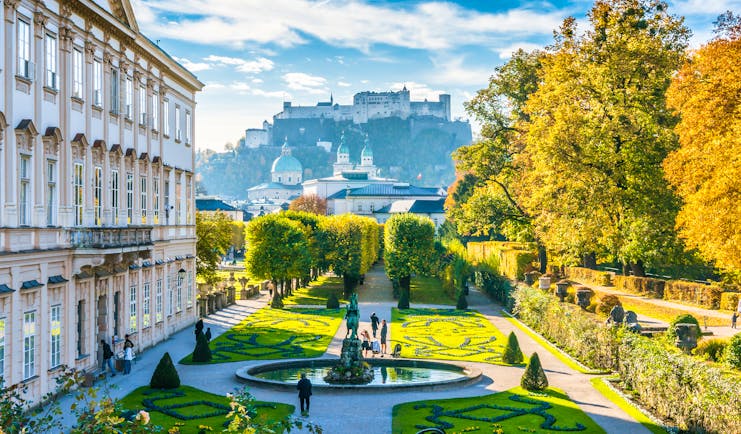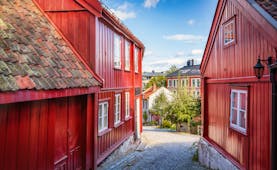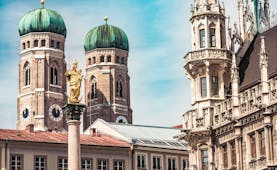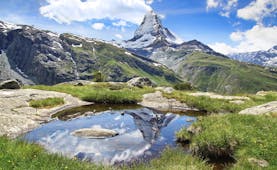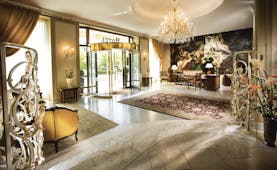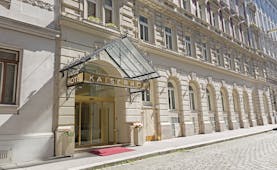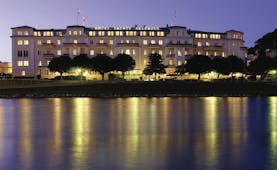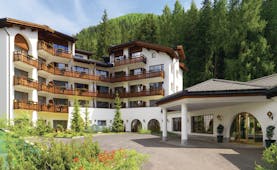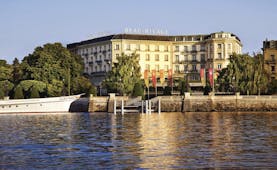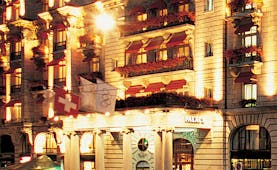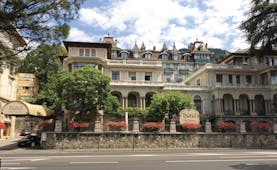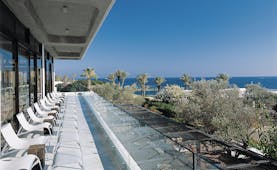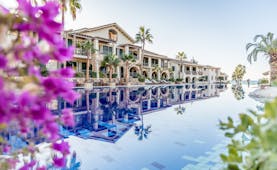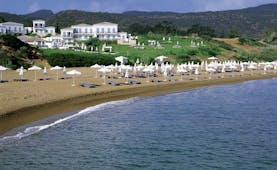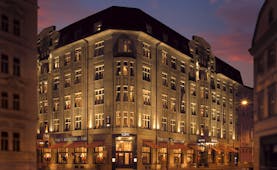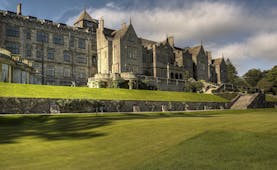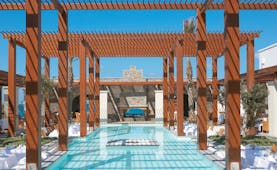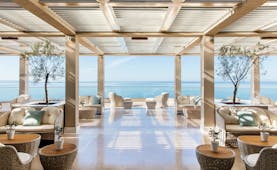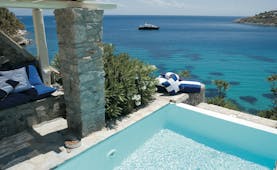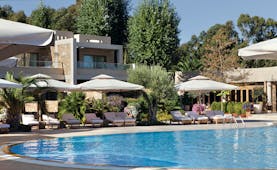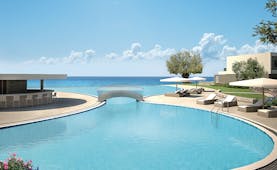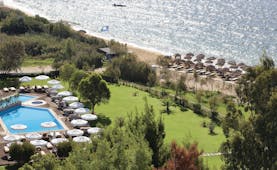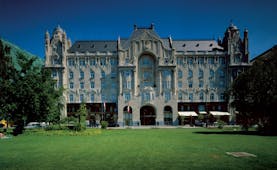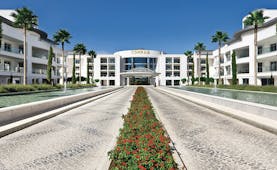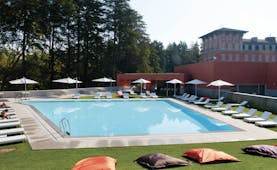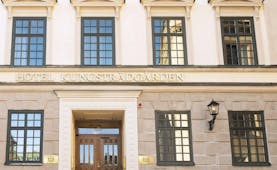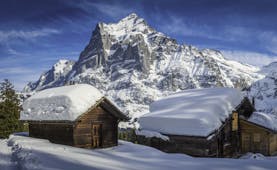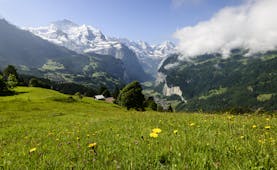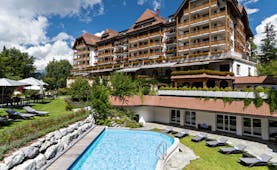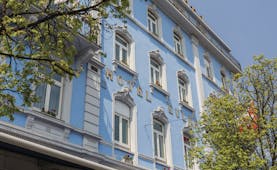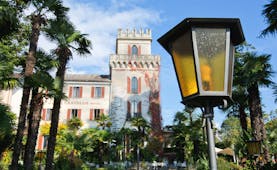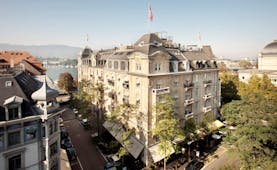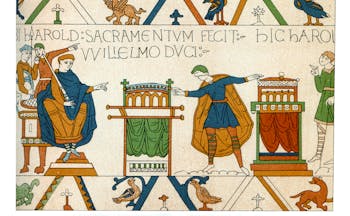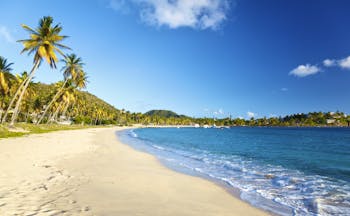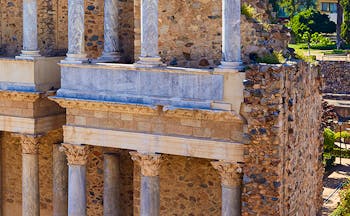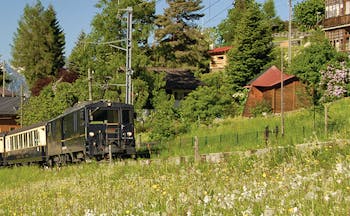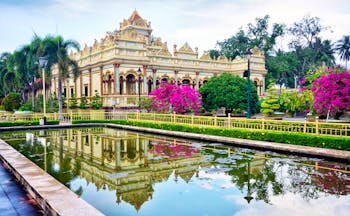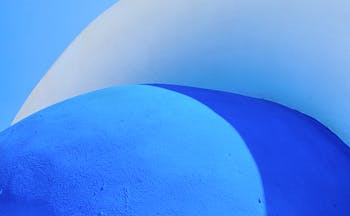Luxury rail tour of the scenic highlights of Switzerland and the Austrian cultural cities of Innsbruck, Salzburg and Vienna
Highlights
Lausanne • Chocolate Train • Glacier Express • Chur • Bernina Express • Tirano • Innsbruck • Salzburg • Vienna • Cologne
Day by day
Leave London mid-morning on the Eurostar to Paris, before changing to a TGV to Lausanne. On arrival here at about 7.30pm transfer to your hotel where you spend two nights.
Spend the day at leisure in Lausanne, making the most of the Swiss Pass which entitles you to unlimited rail travel as well as boat trips. Perhaps travel across Lake Geneva by boat to Evian or Montreux, enjoy a scenic journey on the Golden Pass Line, take a day trip on the Chocolate Train or visit nearby Geneva for the day.
Leave Lausanne just after 9am to travel to Brig, where you board the Glacier Express for the beautiful journey through the mountains on the way to Chur. Continue on through Fiesch and through the Furka tunnel of the Furka Steam Railway that links Realp to Oberwald. This 2 hour stretch weaves its way through the vast panoramas of the mountainsides, passing wooden chalets, the ice caves near the Rhone Glacier, old, wonky houses with moss-covered roofs and light stone walls, and the quaint river and bridge of Oberwald itself. Your next stop will be in Andermatt, nestled in the indomitable Gotthard Pass, initially avoided by the Romans, but conquered when the Scholenen Ravine, an important North-South connection, was established. Zig-zagging roads are dug into and supported above the craggy rocks, overlooking flat agricultural plains and clusters of white houses. To get from Andermatt to the next stop in Disentis, the Glacier Express takes you over the Oberalp Pass; a network of tunnels, viaducts, and winding roads and railway tracks. At its highest point, the Pass reaches 2044m above sea level, affording passengers in the panoramic carriages unforgettable, breath-taking views of undulating green countryside. Disentis itself sits in the upper half of the Anterior Rhine, the Surselva. A large Benedictine monastery crowns the town, which is dominated by snow-capped chalets, mountain views, and is distinctive due to its proximity to the source of the Rhine in Tomasee. From here, travel through the Ruinaulta, or Rhine Gorge, taking in one of the most picturesque landscapes in the Alps, which makes for a sensational experience. The winding river changes altitude beside the railway tracks, passing sheer white cliffs, hilltop towers, and slinking under arched viaducts. Check in to your hotel in Chur for two nights.
Take a day trip on the Bernina Express, allowing you to enjoy one of the world’s most spectacular rail journeys whilst travelling to Tirano and back. The journey takes you around and through sheer rock faces, alongside crystal-clear lakes and through switchbacks as you negotiate the stunning terrain. Travel through the Ruinaulta, or Rhine Gorge, taking in one of the most picturesque landscapes in the Alps. The winding river changes altitude beside the railway tracks, passing sheer white cliffs, hilltop towers, and slinking under arched viaducts. The first stop on the journey is at Tiefencastel, which has ochre-fronted houses, stunning, narrow stone bridges, and is crowned by a solitary tower. The line splits here, bringing passengers to join the train from Davos. Davos is beautiful both when covered with snow and when graced with summer sunlight. It lies on a flat area of land between domed mountains. Small chalets sit beside unique modern buildings, winter resorts, and the tall narrow spire of its church. The Bernina Express will then take you through the Domleschg Region, the area with the most castles and palaces in Switzerland. Some areas of this lush region resemble fairytale English countryside, with paths sheltered by trees and shady groves. One of the highlights of this stretch is the towering curve of the Landwasser viaduct, built in 1901. This route takes you on through Filisur towards Bergun, where you may wish to stop to visit the Bergun Railway Village, home to the Albula Railway Museum and the Railway Adventure Trail. Otherwise, ensure you take in the sight of the crystal-clear blue waters that run in the rivers. From Bergun, the train continues on to Samedan, a small town hemmed in by lakes and the lower verdant banks of the mountains. Hurtle on towards St Moritz, passing the Cresta Run in Celerina, one of the St Moritz area’s most famous attributes. At 1856m above sea level, visitors are welcomed by stunning views across the lakes of the Upper Engadine Valley, and the refreshing dry, clear, Alpine climate. Navigate the local peaks via railway, reaching the Piz Corvatsch, Chantarella, and Corviglia, where a cable car takes you up to Suvretta’s most famous viewing point. If you stay overnight in St Moritz during the summer, you may wish to enjoy the water sports at the sublime Lake Sils and Lake St Moritz, or the windy Lake Silvaplana. Less than 10km from St Moritz is Pontresina, the next stop on the rail route. It sits at the entrance to the Val Bernina on a sloping mountainside terrace, which adds to the village’s quaint majesty. The next leg of the journey, however, passes two exceptional sights: the Montebello Curve and the Morteratsch Glacier. The curve itself has a minimum radius of 45m, turning a total of 180 degrees, and remains one of the most photographed sections of the track. After this brief descent, the Bernina Express gains higher ground; the highest ground, in fact, of the Rhaetian Railway, reaching 2253m above sea level at Ospizio Bernina, your next stop. This secluded station is a beautiful sight, with soft light stone walls and distinctive red shutters on its windows. During the winter months, the building is often cloaked in a blanket of snow. From here, move on to perhaps the most unique stop on the Bernina Express route: Alp Grum. This restaurant is the only restaurant that is exclusively accessed by rail. As a result, the dining experience is equally exclusive, with unrivalled views of the Val Poschiavo all the way to the Bergamo Alps. If you wish to dine here this is best done on a day trip from St Moritz. The journey then takes you on to Poschiavo itself, a town surrounded by rich, deep green vegetation, with a serene lake on one side. Then, the train will stop in Le Prese, a small village captured in a bubble of peace and quiet. Next, the Bernina Express takes you through to Brusio. Though not a stop, this particularly unique viaduct stretch has a novel way of negotiating the changing altitudes. After coming along the mountainside, the track spirals back on itself, allowing passengers plenty of time to take in the views before they descend under the viaduct they have just passed over. The Bernina Railway ends across the Italian border in Tirano, after passing orchards and vineyards, where the influences of Italy can already be seen in the architecture of the townhouses lining the riverside. You have time for a brief stop in Tirano before taking the Bernina Express back to Chur where you spend a second night.
Leave Chur mid-morning on a train to Innsbruck, changing in Sargans on the Swiss side of the border. The high mountains, the roof of Europe, loom in the distance. You sense them more than you see them. Suddenly with Feldkirch you are in Austria and after Bludenz the train climbs up along the Arlberg. As the cars disappear into the road tunnel below, the train continues to climb, ducking in and out of tunnels for the last part of the climb, until you emerge at St Anton. After the descent into the Inn valley, it is definitely the Austrian Tirol: traditional haystacks, onion-domed churches, wayside chapels. From the Oetztal station, you know the road heads south to Obergurgl and the Timmelsjoch high Alpine road into Italy. The train continues along the Inn valley, passing lush pastureland and Tirolean villages, including that of Stams, famous for its monastery. The Olympic ski jump at Igls to the right of the train indicates the imminent arrival in Innsbruck. Arrive in Innsbruck in the afternoon. You have the rest of the day and the evening to explore the city and its array of architectural gems from the Gothic, Renaissance, Baroque and Neo-Classical period. You spend one night in Innsbruck.
Enjoy breakfast at your hotel and board a direct train to Salzburg where you will arrive in under two hours. As you leave Innsbruck, ski slopes are visible in the distance, and you know that Kitzbuehel is off to the south-east but at Kufstein the train crosses into Germany and the landscape flattens slightly with fields and forests yet the Chiemgau Alps are in the near distance. The train travels to the south of the Chiemsee and then Austria approaches once more. There is a spectacular although fleeting moment as the train crosses the river Salzach and on the right you are dazzled by the spires and turrets of the old city of Salzburg and Festung Salzburg on the hill-top on the horizon. Check in to your hotel for a stay of two nights.
You have a full day in Salzburg to discover this compact and very attractive city. Famous for being the birthplace of Mozart and the location for “The Sound of Music”, there are also numerous gardens and intricate architecture to enjoy, notably striking Baroque churches and buildings designed by Fischer von Erlach. The often piercing green-grey waters of the Salzach River flow through the city centre and the old town is on the left bank where you can find the Hohensalzburg Fortress, an 11th century castle which sits upon the Festungsberg. Other places of interest include the Mirabell Palace Gardens – a UNESCO World Heritage Site - and Mozart’s birthplace, a museum which tells the compelling story of his life, relationships and musical inspirations. Today, the Salzburg Festival in July and August each year, offers an array of opera, music and drama.
After a leisurely breakfast in Salzburg, board a direct rail service to Vienna, where you will arrive in under 2 and a half hours. After Salzburg, the countryside becomes a patchwork of arable fields and large farmhouses before the more built-up stretch between Wels and Linz. It is at Linz you meet the Danube and then you cross from Upper Austria into Lower Austria, leaving the trail of the Danube to meander further north, cutting its own gorge above the Wienerwald before it reaches Vienna. You may not see it at all during your stay in Vienna. Check into your hotel in Vienna for 3 nights.
You have two full days to explore Vienna at leisure. Vienna, on the banks of the River Danube, has been at the heart of central European history since the Roman times. Vienna never fails to impress and satisfy the visitor eager for historical and cultural references. ‘Dream and reality’ still resonate and your days in Vienna can be filled with a mixture of galleries, museums, opera, concerts or eating and drinking in a ‘Heuriger’ in the Vienna Woods. The history of Vienna can be witnessed in the Roman Museum, the Neidhart frescoes dating from the 1400s, the mediaeval Basiliskenhaus, the Imperial Palace and the numerous Jugendstil buildings, and of course in the City of Vienna museum. The Hofburg contains numerous national collections from the Crown Jewels to the Imperial armoury. Take time to listen to the Mozart Orchestra playing in the Musikverein, and to enjoy coffee and cake at Demel’s. A fun way to see the sights of the city is to take a tram around the Ringstrasse, hopping off and on as you want.
Spend the day at leisure in Vienna, before boarding a night train to Cologne at about 20.00 hrs. We include a two-berth sleeper.
Arrive in Cologne just before 9am, change trains for Brussels. In Brussels you transfer to the Eurostar for the final leg of your holiday back to London St Pancras. You reach London in the late afternoon.
I wanted to take a moment to thank you for organizing our recent trip. We had a fantastic time, staying in some excellent hotels in wonderful locations.Mr M, August, 2024
Holiday price guide From about £3,220 per person based on two people sharing a double room and including for second class rail travel. First class supplement about £700 per person.
Holiday Code EEBR02
Call us on 01392 441245
Luxury rail tour of the scenic highlights of Switzerland and the Austrian cultural cities of Innsbruck, Salzburg and Vienna
Leave London mid-morning on the Eurostar to Paris, before changing to a TGV to Lausanne. On arrival here at about 7.30pm transfer to your hotel where you spend two nights.
Spend the day at leisure in Lausanne, making the most of the Swiss Pass which entitles you to unlimited rail travel as well as boat trips. Perhaps travel across Lake Geneva by boat to Evian or Montreux, enjoy a scenic journey on the Golden Pass Line, take a day trip on the Chocolate Train or visit nearby Geneva for the day.
Leave Lausanne just after 9am to travel to Brig, where you board the Glacier Express for the beautiful journey through the mountains on the way to Chur. Continue on through Fiesch and through the Furka tunnel of the Furka Steam Railway that links Realp to Oberwald. This 2 hour stretch weaves its way through the vast panoramas of the mountainsides, passing wooden chalets, the ice caves near the Rhone Glacier, old, wonky houses with moss-covered roofs and light stone walls, and the quaint river and bridge of Oberwald itself. Your next stop will be in Andermatt, nestled in the indomitable Gotthard Pass, initially avoided by the Romans, but conquered when the Scholenen Ravine, an important North-South connection, was established. Zig-zagging roads are dug into and supported above the craggy rocks, overlooking flat agricultural plains and clusters of white houses. To get from Andermatt to the next stop in Disentis, the Glacier Express takes you over the Oberalp Pass; a network of tunnels, viaducts, and winding roads and railway tracks. At its highest point, the Pass reaches 2044m above sea level, affording passengers in the panoramic carriages unforgettable, breath-taking views of undulating green countryside. Disentis itself sits in the upper half of the Anterior Rhine, the Surselva. A large Benedictine monastery crowns the town, which is dominated by snow-capped chalets, mountain views, and is distinctive due to its proximity to the source of the Rhine in Tomasee. From here, travel through the Ruinaulta, or Rhine Gorge, taking in one of the most picturesque landscapes in the Alps, which makes for a sensational experience. The winding river changes altitude beside the railway tracks, passing sheer white cliffs, hilltop towers, and slinking under arched viaducts. Check in to your hotel in Chur for two nights.
Take a day trip on the Bernina Express, allowing you to enjoy one of the world’s most spectacular rail journeys whilst travelling to Tirano and back. The journey takes you around and through sheer rock faces, alongside crystal-clear lakes and through switchbacks as you negotiate the stunning terrain. Travel through the Ruinaulta, or Rhine Gorge, taking in one of the most picturesque landscapes in the Alps. The winding river changes altitude beside the railway tracks, passing sheer white cliffs, hilltop towers, and slinking under arched viaducts. The first stop on the journey is at Tiefencastel, which has ochre-fronted houses, stunning, narrow stone bridges, and is crowned by a solitary tower. The line splits here, bringing passengers to join the train from Davos. Davos is beautiful both when covered with snow and when graced with summer sunlight. It lies on a flat area of land between domed mountains. Small chalets sit beside unique modern buildings, winter resorts, and the tall narrow spire of its church. The Bernina Express will then take you through the Domleschg Region, the area with the most castles and palaces in Switzerland. Some areas of this lush region resemble fairytale English countryside, with paths sheltered by trees and shady groves. One of the highlights of this stretch is the towering curve of the Landwasser viaduct, built in 1901. This route takes you on through Filisur towards Bergun, where you may wish to stop to visit the Bergun Railway Village, home to the Albula Railway Museum and the Railway Adventure Trail. Otherwise, ensure you take in the sight of the crystal-clear blue waters that run in the rivers. From Bergun, the train continues on to Samedan, a small town hemmed in by lakes and the lower verdant banks of the mountains. Hurtle on towards St Moritz, passing the Cresta Run in Celerina, one of the St Moritz area’s most famous attributes. At 1856m above sea level, visitors are welcomed by stunning views across the lakes of the Upper Engadine Valley, and the refreshing dry, clear, Alpine climate. Navigate the local peaks via railway, reaching the Piz Corvatsch, Chantarella, and Corviglia, where a cable car takes you up to Suvretta’s most famous viewing point. If you stay overnight in St Moritz during the summer, you may wish to enjoy the water sports at the sublime Lake Sils and Lake St Moritz, or the windy Lake Silvaplana. Less than 10km from St Moritz is Pontresina, the next stop on the rail route. It sits at the entrance to the Val Bernina on a sloping mountainside terrace, which adds to the village’s quaint majesty. The next leg of the journey, however, passes two exceptional sights: the Montebello Curve and the Morteratsch Glacier. The curve itself has a minimum radius of 45m, turning a total of 180 degrees, and remains one of the most photographed sections of the track. After this brief descent, the Bernina Express gains higher ground; the highest ground, in fact, of the Rhaetian Railway, reaching 2253m above sea level at Ospizio Bernina, your next stop. This secluded station is a beautiful sight, with soft light stone walls and distinctive red shutters on its windows. During the winter months, the building is often cloaked in a blanket of snow. From here, move on to perhaps the most unique stop on the Bernina Express route: Alp Grum. This restaurant is the only restaurant that is exclusively accessed by rail. As a result, the dining experience is equally exclusive, with unrivalled views of the Val Poschiavo all the way to the Bergamo Alps. If you wish to dine here this is best done on a day trip from St Moritz. The journey then takes you on to Poschiavo itself, a town surrounded by rich, deep green vegetation, with a serene lake on one side. Then, the train will stop in Le Prese, a small village captured in a bubble of peace and quiet. Next, the Bernina Express takes you through to Brusio. Though not a stop, this particularly unique viaduct stretch has a novel way of negotiating the changing altitudes. After coming along the mountainside, the track spirals back on itself, allowing passengers plenty of time to take in the views before they descend under the viaduct they have just passed over. The Bernina Railway ends across the Italian border in Tirano, after passing orchards and vineyards, where the influences of Italy can already be seen in the architecture of the townhouses lining the riverside. You have time for a brief stop in Tirano before taking the Bernina Express back to Chur where you spend a second night.
Leave Chur mid-morning on a train to Innsbruck, changing in Sargans on the Swiss side of the border. The high mountains, the roof of Europe, loom in the distance. You sense them more than you see them. Suddenly with Feldkirch you are in Austria and after Bludenz the train climbs up along the Arlberg. As the cars disappear into the road tunnel below, the train continues to climb, ducking in and out of tunnels for the last part of the climb, until you emerge at St Anton. After the descent into the Inn valley, it is definitely the Austrian Tirol: traditional haystacks, onion-domed churches, wayside chapels. From the Oetztal station, you know the road heads south to Obergurgl and the Timmelsjoch high Alpine road into Italy. The train continues along the Inn valley, passing lush pastureland and Tirolean villages, including that of Stams, famous for its monastery. The Olympic ski jump at Igls to the right of the train indicates the imminent arrival in Innsbruck. Arrive in Innsbruck in the afternoon. You have the rest of the day and the evening to explore the city and its array of architectural gems from the Gothic, Renaissance, Baroque and Neo-Classical period. You spend one night in Innsbruck.
Enjoy breakfast at your hotel and board a direct train to Salzburg where you will arrive in under two hours. As you leave Innsbruck, ski slopes are visible in the distance, and you know that Kitzbuehel is off to the south-east but at Kufstein the train crosses into Germany and the landscape flattens slightly with fields and forests yet the Chiemgau Alps are in the near distance. The train travels to the south of the Chiemsee and then Austria approaches once more. There is a spectacular although fleeting moment as the train crosses the river Salzach and on the right you are dazzled by the spires and turrets of the old city of Salzburg and Festung Salzburg on the hill-top on the horizon. Check in to your hotel for a stay of two nights.
You have a full day in Salzburg to discover this compact and very attractive city. Famous for being the birthplace of Mozart and the location for “The Sound of Music”, there are also numerous gardens and intricate architecture to enjoy, notably striking Baroque churches and buildings designed by Fischer von Erlach. The often piercing green-grey waters of the Salzach River flow through the city centre and the old town is on the left bank where you can find the Hohensalzburg Fortress, an 11th century castle which sits upon the Festungsberg. Other places of interest include the Mirabell Palace Gardens – a UNESCO World Heritage Site - and Mozart’s birthplace, a museum which tells the compelling story of his life, relationships and musical inspirations. Today, the Salzburg Festival in July and August each year, offers an array of opera, music and drama.
After a leisurely breakfast in Salzburg, board a direct rail service to Vienna, where you will arrive in under 2 and a half hours. After Salzburg, the countryside becomes a patchwork of arable fields and large farmhouses before the more built-up stretch between Wels and Linz. It is at Linz you meet the Danube and then you cross from Upper Austria into Lower Austria, leaving the trail of the Danube to meander further north, cutting its own gorge above the Wienerwald before it reaches Vienna. You may not see it at all during your stay in Vienna. Check into your hotel in Vienna for 3 nights.
You have two full days to explore Vienna at leisure. Vienna, on the banks of the River Danube, has been at the heart of central European history since the Roman times. Vienna never fails to impress and satisfy the visitor eager for historical and cultural references. ‘Dream and reality’ still resonate and your days in Vienna can be filled with a mixture of galleries, museums, opera, concerts or eating and drinking in a ‘Heuriger’ in the Vienna Woods. The history of Vienna can be witnessed in the Roman Museum, the Neidhart frescoes dating from the 1400s, the mediaeval Basiliskenhaus, the Imperial Palace and the numerous Jugendstil buildings, and of course in the City of Vienna museum. The Hofburg contains numerous national collections from the Crown Jewels to the Imperial armoury. Take time to listen to the Mozart Orchestra playing in the Musikverein, and to enjoy coffee and cake at Demel’s. A fun way to see the sights of the city is to take a tram around the Ringstrasse, hopping off and on as you want.
Spend the day at leisure in Vienna, before boarding a night train to Cologne at about 20.00 hrs. We include a two-berth sleeper.
Arrive in Cologne just before 9am, change trains for Brussels. In Brussels you transfer to the Eurostar for the final leg of your holiday back to London St Pancras. You reach London in the late afternoon.
I wanted to take a moment to thank you for organizing our recent trip. We had a fantastic time, staying in some excellent hotels in wonderful locations.Mr M, August, 2024
Holiday price guide From about £3,220 per person based on two people sharing a double room and including for second class rail travel. First class supplement about £700 per person.
Holiday Code EEBR02
Our prices include
● Standard class travel on Eurostar and second-class travel on all other trains (first class and standard premier on Eurostar available at a supplement)
● Double sleeper cabin on the overnight train from Vienna to Cologne
● Second class travel on the Bernina Express from Chur to Tirano return
● 3-day Swiss Pass
● Seat reservations and 3-course lunch on the Glacier Express
● 2 nights’ bed and breakfast in a Superior double room with garden view at Hotel Angleterre et Residence, Lausanne
● 2 nights’ bed and breakfast in a Standard double room at Hotel Stern, Chur
● 1 night’s bed and breakfast in a Standard double room at the Hotel Schwarzer Adler, Innsbruck
● 2 nights’ bed and breakfast in a Classic double room at the Hotel Goldgasse, Salzburg
● 2 nights’ bed and breakfast in a Classic double room at the Hotel Kaiserhof, Vienna
● Concierge service and Expressions Holidays helpful hints
Our prices do not include
● Early check-in or late check-out at any hotels (although we can arrange this on request at additional cost)
● Any other services not mentioned above, such as transfers and meals except breakfast at hotels
● Personal holiday insurance. This is essential and cover should be in place from when you book the holiday.
● Local tourist tax, usually between 1 to 3 Swiss Francs/Euros per person per night, and payable locally to the hotel
● Transfers in Paris
● Transfers in Switzerland or Austria station to hotel unless offered by your hotel
Call us on 01392 441245
Luxury rail tour of the scenic highlights of Switzerland and the Austrian cultural cities of Innsbruck, Salzburg and Vienna

Hotel Angleterre et Résidence is a charming, traditional, Swiss-style, 4-star hotel in a prime location. Delicious cuisine, exceptional service and immaculate grounds offer guests a truly relaxing and indulgent experience.
Superior double room with garden view

Hotel Stern is a 4-star hotel offering both Swiss authentic style and modern comforts in the historic town of Chur. Supremely comfortable accommodation and a traditional, rustic restaurant afford guests a relaxing and restorative experience.
Standard double room

Hotel Schwarzer Adler is a cosy and characterful 4-star boutique hotel, housed in a historic building in the centre of Innsbruck. Delicious local cuisine and luxurious wellness facilities make it an idyllic retreat in a beautiful Alpine location.
Standard double room

The Hotel Goldgasse is a boutique hotel with a modern design, nestled in the centre of Salzburg’s Old Town.
Classic double room

Hotel Kaiserhof Vienna is a four-star hotel in an excellent central location not far from the Karlsplatz. The atmosphere is charming and welcoming, and it is furnished in a traditional way in keeping with the historic building of the hotel.
Classic double room
I wanted to take a moment to thank you for organizing our recent trip. We had a fantastic time, staying in some excellent hotels in wonderful locations.Mr M, August, 2024
Holiday price guide From about £3,220 per person based on two people sharing a double room and including for second class rail travel. First class supplement about £700 per person.
Holiday Code EEBR02
Call us on 01392 441245
Luxury rail tour of the scenic highlights of Switzerland and the Austrian cultural cities of Innsbruck, Salzburg and Vienna
About Austria
An Expressions tailor-made holiday to Austria gives travellers the chance to explore and experience this historic and diversely beautiful country. Crowned by the fading imperial glories of Vienna, with central Europe beckoning out along the Danube to the east, and a stunning, chocolate-box Alpine hinterland to the west, Austria is an unbeatable Mitteleuropa beauty. Throughout its eventful history, Austria has retained a penchant for indulgence, opulent aestheticism, and the cultivation of the higher pleasures in life. Visible in the rolling green pastures that cover the lands between the Alps, and in the grand architecture of the cities, this side to Austria still prevails. Inhabited since the Palaeolithic Age, Austria holds a wealth of dramatic and dynamic history within its fertile valleys. Former seat of the Habsburgs, the Austrian capital of Vienna is strewn with architectural riches. Provincial capitals Linz and Graz are now large, cultural towns with vast open squares, beautifully lit fountains, and hilltop castles, but they still retain their cobbled town centres. Salzburg, the birthplace of Mozart, is smattered with stunning baroque churches, and has an Alpine backdrop straight out of the Sound of Music. The wide turquoise River Salzach separates the modern buildings of recently-built Salzburg from the peaked roofs of the older parts of town, which circle the hill on which the stunning Hohensalzburg Castle is perched. Small boats disappear down the river into the lush green valley beyond, where wooden chalet-style houses climb the riverbanks. With ground-breaking cultural figures peppering Austria's history - Freud, Mozart, Strauss, Schubert, and Klimt, to name but a few - the country is awash with important galleries, concert halls, museums, and opera houses. In fact, you won't need to go in search of culture, in Austria it all but waltzes straight up to you. Coupled with spectacular Gothic churches and baroque cathedrals, this makes Austria a fascinating country to explore, with beautiful old coffee houses and cafes almost every step of the way. Beyond the towns, the Tyrol is a hiker's Promised Land, Innsbruck is the radiant, ethereal winter capital, with an array of ski resorts just a step away, and charming old stone village guest-houses. In summer, cowbells tinkle in flower-filled meadows, gluhwein is forever warming over the fire, and whole holidays can be spent just exploring the lakes, forests, summits, and valleys, without setting foot in a bustling, lively town.
Highlights of Austria
The idyllic pathways along the Danube set the scene for romantic afternoon or evening walks, passing either the city or the hilly green countryside dotted with old castles. Seek out the wine estates and cellars of Grinzing, in order to sample some of the best of Austrian produce in a location beyond compare across Europe. The beautiful, cobbled old town of Innsbruck will introduce you to the indescribable atmosphere of the quaint smaller towns of Austria, and act as your gateway into the untamed, rugged landscape of the Alps. The Bregenz Forest forms one of the main regions in Vorarlberg, and is home to the idyllic villages, tinkling cow bells, and alpine dairies that have become both iconic for the region and synonymous with Austria. The Grossglockner Road is a fantastic 30-mile drive that extends through epic glacial mountain scenery, climbing more than 8,000ft to Austria's highest peak, Mount Grossglockner. The phenomena at Krimml Falls include Europe's highest waterfall, which crashes down from mossy green cliffs over jagged brown rocks. For more of Austria's surprising natural beauty, visit the salt mine and ice caves of Hallstatt, a town of simplistic quaint churches and wooden-panelled houses that cling to the banks of the Hallstatter See. Head back into another of Austria's beautiful cities to see the baroque splendours of Salzburg, before climbing the hill of the Hohensalzburg Castle, the city's crowning glory. Krems an der Donau is a charming university town filled with Heuringen, or traditional wine taverns that seem to blend the iconic Italian love of wine with the rustic, homely establishments of the Alpine countries. The hip town of Linz is full of contemporary architecture, including the gravity-defying Voest Steelworks, which points out towards the undulating horizon. Austria's second city, Graz, has a lovely medieval centre with a buzzing cultural scene. Finally, on every stay in Austria, we would recommend soaking up the peace and serenity available at each of our Austrian hotels; the same peace and serenity that continually makes Austria such a fulfilling holiday destination.
Cultural highlights of Austria
Perhaps begin by exploring Vienna's handsome Gothic churches and the baroque cathedral, which look out over the atmospheric, cobbled streets, the most beautiful of which are situated around the University area of Schottentor. Then stop-off for lunch or a light afternoon snack in one of Vienna's coffee houses, or take one of the trams, straight out of the Third Man, which are a wonderfully romantic way to get about town. Admire the vast imperial facade of Schonbrunn Palace, former seat of the Habsburg Empire, and soak up the sunshine beside the Neptune Fountain in the palace gardens, with the charming arches of the Gloriette as your backdrop. For a taste of the city's intellectual culture, visit the Freud museum or the Kunsthistorisches museum, which houses several paintings by Gustav Klimt. Moving and memorable performances can be watched at Vienna's Spanish Riding School and the Boys’ Choir.
Facts in brief
Capital ViennaAirport Vienna is the main transport hub for Austria, but Graz, Linz, Klagenfurt, Salzburg and Innsbruck all receive international flights.
Size 32,000 sq. miles
Population 8 million
Call us on 01392 441245
Luxury rail tour of the scenic highlights of Switzerland and the Austrian cultural cities of Innsbruck, Salzburg and Vienna
About Grisons and the Engadine
Dotted with National Parks, Grisons and the Engadine are best known for the dramatic Alpine scenery and the major winter sports resorts; yet, in the spring, summer, and autumn months, the region has far more to offer. Historic towns, scenic lakes and glaciers, and chic villages packed with gourmet restaurants and boutique shops come into their own in the sunshine. The Ela Park, through which the world-famous Glacier Express and Bernina Express run, stretches between Chur and St Moritz. Passing through here by car or rail will introduce you to miles-upon-miles of quintessentially Swiss landscape: lush, natural fields are interspersed with evergreen forests, clusters of rustic wooden houses, and jagged mountain peaks such as the Lenzerhorn, Piz Vadret, Piz Platta, as well as Piz Bernina in the distance. Visitors to this region in the summer have these sublime panoramas as their object. The Engadine is known for its sporting possibilities. Hiking and walking trails take you up to the most sought-after and secluded vantage points, and the extensive network of cycling paths offer endless destinations; one route even leads to Budapest.
Highlights of Grisons and the Engadine
Between the peaks, valleys, and lakes of Grisons and the Engadine, towns and villages with hidden cultural treasures abound. Some of the oldest settlements in Switzerland are located here, still with the same medieval atmosphere. One of the most iconic images associated with Grisons is Tarasp Castle, built in the 11th century, perched on its hundred-metre-high rock in the centre of its surrounding valley. To see more of traditional Engadine style, visit the ancient villages of Guarda, Ftan, and Sent. The village of Zernez is known as the ‘Gateway to the Swiss National Park,' which also extends south into Italy. The Inn Valley is the perfect place to admire your surroundings. 60km of hiking trails wind their way across the landscape between Maloja and Scuol, believed to be the most rewarding trails in Switzerland because of the high-altitude views. Between the months of May and September, the Inn Valley gorges are ideal for rafting, as their calm turquoise waters bustle white. The Bains Engadine in Scuol were the first Roman-Irish baths in Switzerland, now providing saunas and pools with a very impressive backdrop.
Cultural highlights of Grisons and the Engadine
The three main towns of interest are Chur, Davos, and St Moritz. Chur is the oldest city in Switzerland, affectionately named the ‘Alpine City.’ Twisting streets and historic buildings, restaurants, bars, museums, galleries, boutiques, and a pedestrianised Old Town mean the city is abounding in charming character. A farmer's market is held in the main square of the Old Town every Saturday morning between the months of May and October. High above the town stands the Bishop's Palace. Fortified walls surround the central courtyard, which holds the Cathedral of the Assumption, dating back over 800 years. Chur is also home to the region's three largest museums. Explore its history in the Rhaetian Museum, the works of prestigious local artists at the Museum of Fine Art, and the flora, wildlife, and geological history at the Graubunden Natural History Museum. The two most popular mountain peaks in the area around Chur are the Branbruesch and the Dreibundenstein, both accessible by cable car and hiking routes. Chur has the highest concentration of restaurants and bars in Switzerland, making it an excellent destination for gastronomists and those who enjoy sampling a range of delicacies in a new restaurant each night. The highest ‘town’ in the Alps, at 1560m above sea level, is Davos, another popular destination with winter sports enthusiasts. In the summer, however, the snow melts to reveal over 700km of hiking paths. These can be accessed via cable cars up to the Jakobshorn (2590m), the Weissflujoch (2844m), and the Rinerhorn (2490m). Horse-drawn carriages take you along the narrower valleys of Sertig, Dischma, and Fluela. At Davos Lake, visitors can take a refreshing swim or enjoy the sports available at the sailing and surfing area. Alternatively, visit the Zugenschlucht gorge to follow the geology trail, the rocky path of the river, or to visit the mining museum. For something even more unusual, spend an hour at the Monstein Brewery, the highest brewery in Europe, and the first in Switzerland to be opened for tastings and tours. St Moritz is perhaps the best-loved Alpine winter destination in Switzerland, and possibly Europe. At 1822m above sea level, visitors are welcomed first by views across the Upper Engadine Valley. The local peaks, including the Piz Corvatsch, Chantarella, and Corviglia can be reached via mountainside railway, and from Corviglia, you can take a cable car up to Suvretta's most famous viewing point. Though St Moritz is not a waterside village, the nearby Lake Sils and Lake Silvaplana are perfect for water sports, particularly the latter, which is known for being windy. The village of St Moritz itself is smattered with quaint cafes and stunning buildings with peaked roofs, and the central churches provide beautiful destinations after a morning of exploration on foot. Just outside St Moritz is Celerina, home to the Cresta Run, one of the area's most famous attributes. Celerina is also the first stop on the Glacier Express route from St Moritz to Zermatt: a journey of viaducts, steep inclines, spiralling declines, and some of Switzerland's most famous mountains.
Festivals in Grisons and the Engadine
In Switzerland there is only one nationally celebrated day, the Anniversary of the Founding of the Swiss Confederation on the 1st August, aside from Christmas, advent and New Year. Apart from these, festivals and holidays are determined by the canton and the town. The residents of Grisons see in the first day of March with Chalanda Marz, in which bells are rung to chase out the winter. In Disentis on July 11th, a religious procession takes place to honour Saint Placidus. In Pontresina, St Moritz, and across the canton, the BSI Engadine Festival brings the region to life with performances of classical music in August. The most unusual of the major festivals in Grisons and the Engadine may well be in Chur, at the Chur City Festival and Alpine Beard Festival in August. In the autumn, Chur Theatre performs a diverse international theatre and dance programme, and in August every two years open-air opera is performed at the Haldenstein Castle.
Gastronomy in Grisons and the Engadine
As Grisons is still comprised of three language areas (Italian, German, and Romansh), the cuisine remains eclectic and varied. Many ingredients, prominent in the Alpine terrain are recombined in new ways to create different, flavoursome dishes. Three popular dishes in particular are maluns, capuns, and pizokels. Maluns are made from boiled potatoes, which are then grated, rolled in flour, and then roasted in butter. Often eaten by farmers for breakfast, maluns are also popular snacks to accompany a cup of coffee or served with Alpine cheese at dinner. Capuns come in a range of varieties, but are always wrapped in savoy cabbage leaves, spinach leaves, or Swiss chard. Inside, they have some combination of dough, meat, fish, and vegetables. Pizokels are baked dishes of special dough and vegetables topped with cheese.
Call us on 01392 441245
Luxury rail tour of the scenic highlights of Switzerland and the Austrian cultural cities of Innsbruck, Salzburg and Vienna
About Lake Geneva
An Expressions tailor-made holiday to Lake Geneva is an ideal way to experience the beauty and serenity of this Swiss region. Marking a crescent-shaped segment of the France-Switzerland border, Lake Geneva is named after diplomatic, historic Geneva. French spa towns on the southern shore look across to the Swiss Riviera on the northern side, characterised by grand palatial buildings and hotels, promenades lined with trees, and tumbling fountains. Lake Geneva is popular for water sports and hiking holidays, as well as relaxing lakeside spa breaks; and, in the winter, it is close enough to the ski slopes to make a very laid-back skiing destination. Chic towns and villages sit behind rows of palm trees, basking in the Mediterranean climate, sheltering gourmet restaurants, luxury boutique shops, and a range of stunning Swiss hotels. Prestigious buildings, at the seat of European politics, call these idyllic towns home, adding a sense of importance to the atmosphere of the peaceful streets. There is perhaps nowhere more glamorous in Switzerland than Lake Geneva, and nowhere where the history and culture is so grand and visually captured in the buildings, parks, and gardens. With such close proximity to Geneva airport and the major railway lines, Lake Geneva is an excellent first or last stop on a touring holiday.
Highlights of Lake Geneva
Montreux, on the most eastern point of the lake is most famous for the Montreux Jazz Festival, which is held in international esteem. One of the most iconic sights, for both Switzerland and Montreux, is of Chillon Castle, jutting out on a rocky outcrop into the lake waters. This castle cannot be missed because of its fairy-tale beauty. You can also begin to explore the landscape around Montreux by rail. One railway takes you across Alpine meadows to Rochers-de-Naye at more than 2000m above sea level, from which you can sometimes see the Jet d'Eau in Geneva. The Swiss Chocolate Train, adorned with lavish Belle Epoque carriages, travels to the village of Gruyeres, where characterful old cobbled streets are lined with townhouses containing cafes and three museums. An imposing medieval castle sits at the top of the village. You can also reach the Maison Cailler on the Chocolate Train, where you learn about traditional Swiss chocolate-making and even make some of your own. The Vineyard Train (number S31) will take you through the 800 hectares that make up the Lavaux Terraced Vineyards from Vevey to Puidoux-Chexbres. The vineyards are the largest living cultural site in Switzerland and a recognised UNESCO World Heritage Site. Further west from the Lavaux Vineyards is Lausanne, home to the International Olympic Committee headquarters, but perhaps best known for simply being a particularly romantic and beautiful Swiss town. Gardens, promenades, and lakeside pathways ensure that your days here are as picturesque as they are cultural. At Lausanne's heart stands the Cathedral, believed to be one of Europe's most beautiful Gothic monuments. The purple and orange hues of its two main spires are visible throughout the town. It was originally built in the 12th and 13th centuries. In contrast with the Cathedral, immersed in the history of the cobbled Old Town, a new Olympic Museum has recently opened. Interactive displays illustrating the colourful history of the games are spread over three levels and include more than 1,000 objects and 150 screens. One of the highlights of the museum, however, is the Olympic Park. The artworks, sports sculptures, and beautiful patches of well-maintained nature provide a stunning setting for this modern cultural venture. From here, you can wander down the promenade at Ouchy, an area that is unrelentingly popular with residents. This promenade takes you to the Haldimand Tower, the Bellerive Swimming Pool, the Chateau d'Ouchy, and the port.
Cultural highlights of Lake Geneva
Any stay on Lake Geneva remains incomplete without a visit to the city that gives it its name. One of the key features of Geneva's cultural heritage is its place as the origin of fine watch-making. Workshops, boutiques, and museums all provide an insight into this prestigious craft. Even the Jet d'Eau fountain bears some connection, as it originally harnessed the power of the Rhone for the craftsmen of Geneva. Today, it acts as a captivating, animate monument to the skills, craft, and natural forces of the city. Geneva is also home to the Palais des Nations, the European headquarters of the UN. Guided tours take visitors through the building, which seems to blend geometric modern design with classical, palatial style. Geneva's Old Town, or Vieille-Villa, is the largest in Switzerland, laced with narrow alleyways and charming squares, and centred around the St Pierre Cathedral. 157 steps will take visitors to the top of the cathedral tower in order to appreciate the remarkable views over the fascinating jumble of unique townhouses. A very unique feature of Geneva is the Flower Clock in the Jardin Anglais. This precise and beautiful clock has the longest second hand in the world. Visitors interested in Swiss art and modern culture should spend an afternoon in the Quartier des Bains, wandering around the MAMCO and the Centre d'Art Contemporain before enjoying dinner in a chic bistro. Mediterranean Carouge is Switzerland's gateway to the south, with abundant Sardinian style. Finish your exploration with one of the four world-exclusive museums: the International Museum of the Red Cross and Red Crescent, Le Musee International de la Reforme, the Patek Philippe Museum, and the Bodmer Foundation Library and Museum.
Festivals in Lake Geneva
Much of the canton of Geneva's culture is built around a celebration of its history and traditions. Perhaps one of the liveliest celebrations is the Oktoberfest, though many more unusual festivals prove equally enjoyable. In the first two weeks of February, the Antigel Festival brings a variable programme of music, dance, and other performances to the less likely stages. In March, the International Geneva Motor Show, largest of its kind in Europe, unveils a range of new innovative designs at the Palexpo Exhibition Centre. Similarly, in April you can visit the International Exhibition of Inventions, New Techniques, and Products in the same venue. On specific dates of the year, usually mid-May, a selection of museums stay open for the whole night, an event that is also celebrated in a number of bars. Also in May is a Day of Open Wineries, where upwards of 90 wineries open their doors for free to wine-touring visitors. A charge of 5CHF at one winery will enable you to taste wines at every other winery for no further charge. In June and July, parks, gardens, and secluded outdoor spots on the lake shores play host to a range of live music and DJ sets at the Ecoutes au Vert Festival. In the middle of June each year, Lake Geneva is transformed into the largest sailing regatta in Europe, with over 500 boats competing. Geneva's largest music festival is the Geneva Music Festival in late June, specialising in a range of musical genres, and accompanied by an array of food stalls. Impossible to forget is the Montreux Jazz Festival, founded in 1967, that brings an eclectic range of performances to the lakeside stages, not limited to Jazz. The Cine Transat, hosted in one of Geneva's parks, features a series of French and English films. The Prelude to the Geneva Festival and the Geneva Festival itself take place from the middle of July until the first week of August and are widely believed to be the highlight of summer in the region. Carnival rides, concerts, stalls with Swiss delicacies and street food, parades, and variety performances take over the lake shores, topped off with unique firework displays each and every night. The Festival de la Batie from the end of August to mid-September exhibits the works of many local artists from a range of disciplines in Batie Park. The Nuit des Bains sees several galleries in the Quartier des Bains open their doors for free. For a taste of Geneva's history, watch l'Escalade in the Old Town in the second week of December, which commemorates that defence of the city against the Duke of Savoy in 1602.
Gastronomy in Lake Geneva
With over 1,000 restaurants, Geneva is recognised as the capital of culinary delicacies in Switzerland. For decadent dining, choose one of the hotels that line the lake shores; for foreign cuisine, head to the Paquis district; for traditional Swiss dishes, dine in Geneva's Old Town; for Italian restaurants and French cafes, go to Eaux Vives; and for experimental, chic restaurants, eat in Carouge. Some ingredients to look out for in particular are cheeses from Gruyere, oil from Severy, charcuterie, perch, fera, char, and leeks. Vaud, the region in which Lake Geneva sits, is Switzerland's largest wine-growing region, and the most prominent grapes are Chasselas, Pinot Noir, and Gamay. You may also discover some Tartiflette, which originated over the French border in Haute-Savoie, made with Reblocohon cheese.










